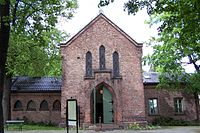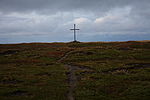- Orthodoxy in Norway
-
Orthodoxy in Norway Our Saviour's Orthodox Church in Oslo. Classification Orthodox Church Geographical areas Norway Origin 1931 Members 8,492 Orthodoxy in Norway is a small minority religion in Norway with 8,492 official members in 2010,[1] up from 2,315 in 2000.[2]
Year Orthodox Percent 1980 ? ? 1990 1,222 0.02% 2000 2,315 0.05% 2005 5,028 0.10% 2010 8,492 0.17% Contents
History of the Orthodox Church in Norway
Since the Viking era Scandinavians and specifically Norwegians came into contact with both the Byzantine Empire and their neighbors, the Russians. Several of the Viking chiefs and kings not only resided in Novgorod but also helped to make Kiev an important medival center. At some point during the late ninth or early tenth century Kiev fell under the rule of Varangians and became the nucleus of the Rus' polity. In a number of contemporary sources it is in fact the Scandinavavians whom were known as "Rus", another term was used for the numerous Slavic tribes.
In the 16th century a Russian missionary, St. Tryphon of Pechenga, evangalized some of the Sami population of Norway and built an Orthodox chapel along the Neiden River. Following the socialist revolution in 1917, a number of Orthodox refugees from Russia fled to Scandinavia, first to Sweden and eventually to Norway. The Orthodox Church in Russia organized pastoral work among them through the church in Stockholm, founded in 1617. In 1931, St. Nikolai church was established in Oslo. This congregation of Russian tradition sorts under the Patriarchate of Constantinople and was the first modern Orthodox congregation established in Norway. The 1960s and 1970s saw in influx of Orthodox from Greece in addition to the first known conversions of Norwegians in modern times. Through immigration from both Russia, the former Yugoslavia and other Eastern European countries the number of Orthodox Chritians in Norway has increased significantly since 1990. The past decade has also seen the more permanent establishment of Orthodox communities of Serbian, Bulgarian and Romanian tradition, the priests of these communities sorting under their corresponding juridstrictions.
The Ecumencial Patriarchate
The first modern Orthodox congregation, St. Nikolai Orthodox Church, is under the juridstriction of the Patriarchal Exarchate for Orthodox Parishes of Russian Tradition in Western Europe. While this adhers to the Russian or Slavic tradition, the Norwegian language is always used along with Slavonic and at times used exclusively. This reflects the missionary tradtion of the Orthodox Church, as in for example the work of Sts. Cyril and Methodius, renowned for helping to create a local alphabet (Cyrillic) in order to translate both the Holy Bible as well as the various liturgical books of the Orthodox Church.
The Patriarchal Exarchate for Orthodox Parishes of Russian Tradition in Western Europe has a total of three priests and one hierodeacon in Norway, two of the priests residing in the Oslo area and one at Greipstad in Songdalen near Kristiansand. The priest in Songdalen is in charge of St. Herman of Alaska Orthodox Community. There are several affiliate or mission communities in Bergen and Stavanger as well as a chapel in Bygstad and St. George's chapel at Neiden. In addition there is a small skete dedicated to St. Tryphon of Pechenga, home to two monks.
The Greek Community
See also: Greeks in NorwayThe primarily Greek congregation of the Annunciation of the Theotokos was founded in 1965 with main purpose of serving the Greek-speaking Orthodox community in Norway. This church sorts under Metropolitan Pavlos Menevissoglou of "Sweden and all of Scandinavia", and is based in Stockholm. The congregation celebrates the Divine Liturgy approximately once a month through the services of Archimandrite Evmenios Likakis or other Greek clergy who travel to Oslo for the occasion.
The Moscow Patriarchate
The main parish of the Moscow Patriarchate, St. Olga's, was founded in Oslo in 1996. Today, there are also independent churches under the Moscow Patriarchate in Stavanger, Bergen, Trondheim and Kirkenes. In addition, the Moscow Patriarchate sponsors work in Tromsø and in the Russian settlement of Barentsburg on Svalbard. Russian communities in North Norway have often been attended to by Russian clergymen of the Moscow Patriarchate.
Oriental Orthodox Churches
There is a fast-growing Oriental Church in Bergen, named Saint Michael' Orthodox Church, with 147 members in 2010 (up from 98 in 2009)[3]. It is almost totally made up of Ethiopians and Eritreans. The number of Eritreans in Norway grew from 813 in 2000 to 7,728 in 2010, while the number of Ethiopians grew from 2,803 to 5,805[4][5].
See also
References
- ^ Statistics Norway
- ^ Statistics Norway
- ^ Fylkesmannen i Hordaland - Norwegian
- ^ "Innvandrarbefolkninga og personar med annan innvandringsbakgrunn, etter innvandringskategori, kjønn og landbakgrunn. 1. januar 2001". Statistics Norway. http://www.ssb.no/innvbef/arkiv/tab-2001-10-29-05.html.
- ^ "Persons with immigrant background, by immigration category, country background and gender. 1 January 2011". Statistics Norway. 2011. http://www.ssb.no/english/subjects/02/01/10/innvbef_en/tab-2011-04-28-04-en.html.
External links
- The Moscow Patriarchate Churches in Norway
- The Annunciation of the Theotokos (Greek parish - Oslo)
- St. Nikolai Orthodox Church (Oslo)
- St. Herman of Alaska Orthodox Community (Southern Norway)
Bahá'í Faith · Buddhism · Christianity (Protestant Churches (Adventist Church · Anglican Church · Baptist Church · Lutheran Churches (Church of Norway · Evangelical Lutheran Free Church of Norway) · Pentecostal Church, Roman Catholic Church, Orthodox Church, Nontrinitarian Church, Restorationist Church, Mormon Church) · Hinduism · Islam · JudaismOrthodox Christianity in Europe Sovereign
states- Albania
- Andorra
- Armenia
- Austria
- Azerbaijan
- Belarus
- Belgium
- Bosnia and Herzegovina
- Bulgaria
- Croatia
- Cyprus
- Czech Republic
- Denmark
- Estonia
- Finland
- France
- Georgia
- Germany
- Greece
- Hungary
- Iceland
- Ireland
- Italy
- Kazakhstan
- Latvia
- Liechtenstein
- Lithuania
- Luxembourg
- Macedonia
- Malta
- Moldova
- Monaco
- Montenegro
- Netherlands
- Norway
- Poland
- Portugal
- Romania
- Russia
- San Marino
- Serbia
- Slovakia
- Slovenia
- Spain
- Sweden
- Switzerland
- Turkey
- Ukraine
- United Kingdom
- (England
- Northern Ireland
- Scotland
- Wales)
States with limited
recognition- Abkhazia
- Kosovo
- Nagorno-Karabakh
- Northern Cyprus
- South Ossetia
- Transnistria
Dependencies
and other territories- Åland
- Faroe Islands
- Gibraltar
- Guernsey
- Jan Mayen
- Jersey
- Isle of Man
- Svalbard
Other entities Categories:
Wikimedia Foundation. 2010.


